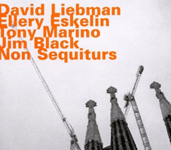|
|
 |
Dusted Reviews
Artist: David Liebman & Ellery Eskelin Album: Non Sequiturs Label: Hatology Review date: Sep. 20, 2012 |

|
|
|
 |
Few jazz formats are more hallowed than the two-tenor summit, and few can be as yawn-inducing. So it was understandable when, back in 2004, there was a great frisson of excitement when the idiosyncratic stylists Dave Liebman (who also has the straight horn in his repertoire) and Ellery Eskelin started gigging and recording. It’s our good fortune that they’ve kept up the association, in the company of Liebman’s longtime bassist Tony Marino and Eskelin’s frequent associate, percussionist Jim Black. With their third Hatology record, Non Sequiturs, the quartet is as expansive, challenging, and enjoyable as ever.
The band works inside and out, with boundaries not a problem — not even a challenge so much as another dimension of structure to romp through and around. You want your jazz to range from free to post-bop and back? Got it. Do you crave a range from micro-texture to elaborate sectional composition? Check. Non Sequiturs is delicate, slammin’, swinging, abstractly wail, and sweetly romantic. They take it all in, with Marino and Black both dropping and cutting off the anchor throughout, mischievous when you’re not looking but always ready to grab hold of the music before it untethers completely.
From the opening notes of the nimble, careening swinger “New Breed” (which longtime Liebman fans will recognize from his 1970s sides with Elvin Jones), the exploration is exuberant and unceasing, no matter the mood. The dark hues of the twin tenors on Liebman’s “In the Mean Time” to some extent recall Tim Berne’s band Bloodcount (of which Black was a stalwart member) in terms of timbre; and its slow gathering and dissolution of lines and rhythmic shapes bears some methodological similarity to that combo, too. But the limber, woody groove that emerges is distinctive and hypnotic (Black is absolutely central here, playing his toms like timbales, rocking insistently), with urgent lines suspended across the pulse. On each of their previous albums, the quartet has dug into at least one repertory tune (from Tadd Dameron’s “Gnid” to Wayne Shorter’s “Vonetta” to Eric Dolphy’s “Out There”). Here, they dig ecstatically into Albert Ayler’s “Ghosts” (now surely some kind of standard). The tenors exult in the tune’s fulsome harmony with curveballs abounding, making the parade and processional their own.
The balance of the album is devoted to Eskelin’s eight-part title suite, which is rhythmically precise and demanding but allows the players to make their own pitch choices. From the close harmony and grainy feel of the brief “No Opening,” the quartet proceeds through successive fragments: the abecedarian “Low Visibility,” the wistful “Main North,” the gathering resolution of “Uncertain Speech” and “Vertical Prose.” But from there, it’s as if they’ve been tamping down the energy only to uncork it for a vigorous final trio of numbers. “Intended Poem” is all mid-tempo swagger.” “Tin Baroque” is a bit of a herky-jerk tune, a vehicle for the quartet to expertly set up a funky groove only to trip over it or race ahead of it. And funky closer “Adjusted Scatter” twists around on its own overlapping lines, Liebman and Eskelin completing each other’s phrases everywhere. People still talk about the apparent “quirkiness” of this saxophonic pairing and about some purported “generational divide” between the players. But you know, the saxophonists themselves have hinted that they sometimes can’t even tell each other apart when the music’s really working. High praise, and it captures the heady joy of both Non Sequiturs and this band.
By Jason Bivins
|







